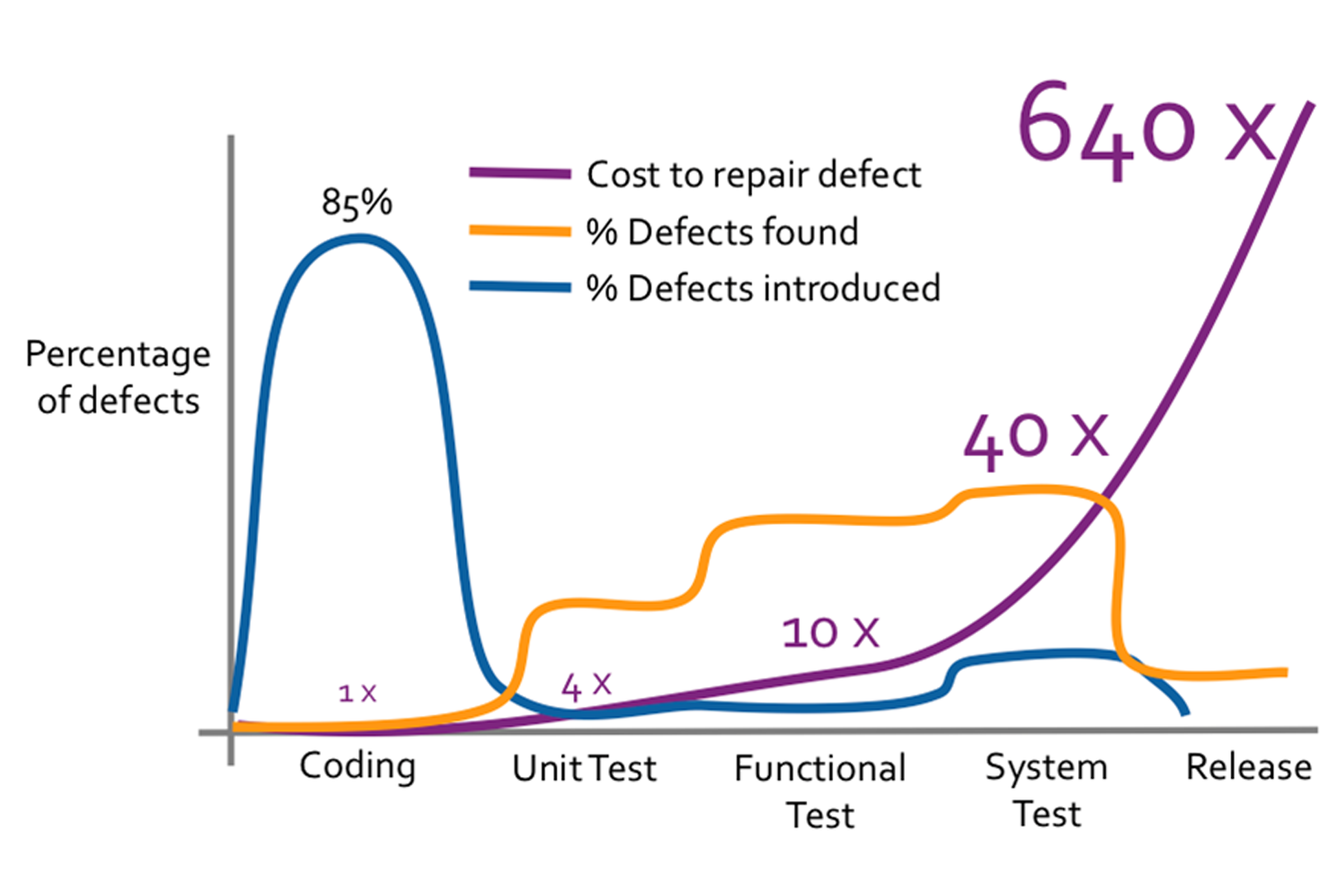See what API testing solution came out on top in the GigaOm Radar Report. Get your free analyst report >>


See what API testing solution came out on top in the GigaOm Radar Report. Get your free analyst report >>
In the race to deliver high-quality software, traditional testing approaches often create a bottleneck at the finish line. Bugs discovered late in the development cycle lead to costly rework and delayed releases. Shift-left testing flips this script as it advocates for proactive quality assurance throughout the software development life cycle (SDLC).
Shift-left testing offers the benefits of catching defects and addressing them before they snowball into major issues by introducing testing activities earlier in the SDLC. However, as with many software testing approaches, shift-left testing includes several types of testing techniques that must be understood by development teams to be effective.
Read on to learn the how and why of shifting testing left. Explore strategies to enhance development efficiency and software quality.

This involves a range of strategies aimed at incorporating early testing and quality assurance into the software development life cycle. Instead of waiting until the later stages of development to initiate testing efforts, shift-left testing emphasizes the importance of testing earlier in the software development life cycle and in parallel with code development.
When testing is injected early on, development teams can identify and address defects, issues, and potential risks before they propagate further into the development process. By doing so, teams save time, resources, and costs associated with rework and refactoring.
Early testing is crucial in the modern software development landscape for several reasons.
First is the obvious one—it enables the early detection and resolution of defects. Addressing defects becomes exponentially more expensive and time-consuming as development progresses. Being able to identify and address issues as early as possible means teams can avoid the compounding effects of technical debt and the costly remediation efforts that often accompany late-stage defect discovery.
Early testing in the development process allows teams to identify and address issues before they become deeply embedded in the application’s architecture. This proactive approach prevents small problems from evolving into more significant, costly challenges and ensures a more stable and robust foundation for the application. By catching defects early, teams can:
With early testing, teams can adopt test-driven development (TDD) and behavior-driven development (BDD) methodologies, which have been proven to improve code quality, maintainability, and overall software robustness.
Furthermore, early testing brings about collaboration and communication between development and testing teams. Given that testers get involved from the outset, there is a chance they can provide valuable insights, feedback, and expertise during the requirements gathering and design phases, all of which go towards delivering quality software.
Traditional or waterfall testing methods are often fraught with several challenges that impact the development efficiency and quality of software products. In the waterfall model, testing occurs after the development cycle leading to five key challenges that bedevil traditional testing approaches:
Shifting testing activities to the left or earlier in the software development life cycle offers numerous benefits that can significantly enhance the overall quality, efficiency, and delivery of software projects. Here are some of the benefits organizations can derive from shift-left testing.
To embrace the shift-left testing approach, it is crucial to integrate development-level testing activities into the development process. Integrating testing practices such as static analysis, unit testing, and functional and nonfunctional testing directly into development allows developers and testers to find and fix defects early, at their source. The following sections will break down various testing techniques and how they align with a shift-left testing strategy.
Shift-left testing thrives on early detection, and static analysis tools are the secret weapon in this proactive approach. Unlike traditional testing methods that require running code, static analysis solutions examine the source code itself, acting like a code detective scrutinizing every line. This meticulous examination uncovers potential bugs, security vulnerabilities, and areas where the code could be written more efficiently.
Static analysis solutions like Parasoft’s C/C++test, dotTEST, and Jtest can be incorporated into development workflows in several ways. Developers can run static analysis scans locally in their development IDEs on their code changes and new feature code before committing them, or they can integrate automated code scans into their CI/CD pipelines to ensure code is scanned each build, allowing for early detection and resolution of issues.
To fully embrace the shift-left development testing approach, organizations should integrate static analysis tools directly into their development workflows.

Unit testing is a fundamental practice in shift-left development testing. It involves creating and running small, isolated tests that verify the behavior of individual units or components of a software system.
Unit tests serve as a safety net because they ensure that new code changes do not break existing functionality. They also provide immediate feedback to developers, allowing them to identify and fix defects in near real-time, reducing the overall time and effort required for debugging and remediation.
Integrating unit testing solutions into the development workflow can help developers validate their code changes and ensure that each unit or component functions as expected. This proactive approach to testing helps to identify and address issues early, preventing them from compounding and becoming more difficult and costly to fix later in the development cycle.
You can think of unit tests as living documentation for the codebase. Well-written unit tests verify the correctness of the code and provide insight into its intended behavior and usage. This documentation aspect becomes valuable when onboarding new team members or maintaining the codebase over time.
To leverage the benefits of unit testing in a shift-left development testing approach, teams should optimize and shift left their test executions.
AI in unit testing solutions further empowers teams to shift left by automating the creation, execution, and maintenance of test cases early in the development cycle. These AI-driven tools, such as Parasoft Jtest for Java applications, can intelligently:
This early and proactive approach accelerates the detection and remediation of defects and also increases developer testing and coding productivity.

In modern software development, applications rarely exist in isolation. They often interact with other systems, services, and APIs, forming intricate integrations and dependencies. Consequently, ensuring the correct integration and interaction between these components becomes crucial for delivering reliable and functional software solutions. This is where API and integration testing plays a vital role in the shift-left development testing approach.
An API testing first strategy helps teams shift left their functional testing by enabling early validation of the core functionalities and interactions between different software components. By focusing on APIs, teams can test the underlying business logic, data processing, and integration points before the user interface is even developed.
Many commercial API test solutions enable teams to leverage API service definition files to generate API component tests. Some, like Parasoft SOAtest, also employ AI to enable teams to generate parameterized API scenario tests from recorded traffic or from service definition files. The ability to leverage service definition files for test creation enables QA teams to start creating test cases in parallel to development.
This early testing ensures that the foundation of the application is robust and that any issues are identified and addressed at the earliest possible stage, significantly reducing the time and effort needed to fix defects later in the development cycle.
Traditionally, integration testing has been primarily the responsibility of dedicated testing teams or quality assurance (QA) professionals. However, in modern Agile practices, most QA teams are embedded with development, which aligns perfectly with the shift-left development testing model. In a shift-left testing strategy, the ownership of integration testing extends beyond the QA team and becomes a shared responsibility among developers, testers, and other stakeholders involved in the software development life cycle.
As advocates of shift-left development testing, developers play a crucial role in ensuring the successful integration of their code with other components and systems. This involvement can take various forms:
Developers can implement smoke tests, which are lightweight tests designed to quickly validate the basic functionality and integration points of their code changes. These tests can be executed locally or as part of the CI/CD pipeline.
Developers can employ contract testing techniques, which involve defining and testing the expected interactions and data contracts between different components or services. This approach makes it possible to catch integration issues early and ensures that all parties adhere to the agreed-upon contracts.
Developers can create and maintain component tests, which verify the behavior of individual components or modules within the broader application context. Component tests ensure that the individual components work properly in isolation, which is required before trying to integrate with other components.

While developers play a key role in integration testing, the QA team’s expertise and involvement remain crucial. QA professionals bring a holistic perspective and can provide valuable insights into the overall system behavior and end user experience. Their responsibilities in integration testing may include the following.
QA teams can develop and execute comprehensive test scenarios that simulate real-world use cases and validate the correct integration and interaction between various APIs, services, and systems. These tests help uncover integration issues that may not be apparent at the component or unit level.
With the proliferation of devices, browsers, operating systems and AI models, it’s essential to validate the application’s compatibility across different environments. QA teams can execute compatibility tests to ensure the integrated system functions correctly on supported platforms.
Integration testing is an ideal opportunity to assess the performance of the integrated system under various load conditions. QA teams can plan and execute performance tests to identify bottlenecks, optimize resource utilization, and ensure the system meets the expected performance requirements.
QA teams can design and execute end-to-end tests that validate the entire application flow, from the user interface to the backend systems, to ensure seamless integration and data flow across all components.
While shift-left development testing emphasizes integrating testing practices into the development phase, the role of quality assurance (QA) teams remains crucial. Shifting testing activities left and embedding QA teams with development enables closer collaboration, provides earlier testing feedback, and allows the entire team to contribute to the overall quality assurance process from the outset. This collaboration bridges the gap between development and testing, ushering in a more cohesive and efficient workflow.
Early involvement of QA teams ensures testing aligns with project requirements and design specifications. QA professionals can provide valuable insights during the requirement-gathering and design phases, ensuring testability is built into the product from the beginning. This alignment helps in creating comprehensive test plans that cover all aspects of the application, including edge cases and potential failure points.

As organizations adopt shift-left testing approaches, QA teams may face scalability challenges. With testing efforts being initiated earlier in the software development life cycle, the volume of tests and the frequency of test execution can increase significantly. This can strain resources, infrastructure, and tooling, potentially leading to bottlenecks and delays in the testing process.
To address these scalability challenges, QA teams need to embrace strategies that enable efficient and scalable testing practices. This may involve leveraging cloud-based testing platforms, implementing parallelization techniques, optimizing test suite execution with test impact analysis, and adopting risk-based testing approaches to prioritize critical areas.
A lean web UI test strategy is an approach that urges QA teams to think critically about what type of test they should create to validate functionality or to meet their testing requirements. Many QA teams overrely on UI and end-to-end testing to validate business logic. However, in many cases testing can shift left from the UI layers to the API layers enabling teams to start their functional testing much earlier in the development life cycle. This is not to say that teams should abandon UI or end-to-end testing as it’s required to validate user interface interactions, end user workflows, and cross-browser compatibility, and more.
Here are some tips for teams adopting a lean web UI test strategy.
Implementing a lean web UI test strategy can yield numerous benefits for QA teams and the overall software development process. Below are some of the specific benefits:
API testing solution like Parasoft SOAtest leverage AI to help teams easily adopt a lean web UI test strategy. With the Smart API Test Generator, teams can convert automated web UI test suites in any test framework to API scenario tests for RESTful services. This allows teams to leverage their existing web UI test suite to generate API scenario tests to validate the business logic.
Shifting left nonfunctional testing involves integrating nonfunctional testing activities, such as performance, security, and accessibility testing, early in the development life cycle.
Moving these tests to earlier phases enables teams to identify and address potential problems before they boomerang out of control. Early nonfunctional testing ensures that the software meets performance benchmarks, security standards, and accessibility requirements from the outset, leading to a more robust and reliable product. This approach also aligns well with Agile and DevOps practices as it promotes continuous iterative improvement.
Deferring nonfunctional testing until the later stages of development can pose significant challenges and risks.
Designing functional tests that can be extended to support other testing methods such as nonfunctional testing, save both time and resources. Reusing existing functional test cases and repurposing them enables teams to start testing for nonfunctional requirements much earlier than traditional workflows. Often nonfunctional testing like performance, security penetration, or accessibility testing are left to the later stages of testing and are conducted by siloed teams. The ability to repurpose existing tests allows Dev and QA teams to become more involved in the validation of nonfunctional requirements and to start testing earlier.
Additionally, reusable tests are easier to maintain and update. When a test case needs to be updated, updates to the functional test case can be applied universally. This consistency ensures all software aspects are evaluated against the same standards, leading to more reliable and high-quality results.
Service virtualization is a technique that simulates the behavior of components in a software application, such as APIs, databases, and third-party services, that are not readily available or are difficult to access during development and testing. It creates a virtual environment that mimics the functionality and performance of these components, allowing developers and testers to work independently of external constraints.
Service virtualization plays a crucial role in enabling shift-left testing by allowing teams to start testing much earlier in the development process. It provides virtual representations of unavailable or incomplete components, enabling developers and testers to validate interactions and performance without waiting for the actual services to be developed or become accessible.
This early testing capability helps identify defects and performance issues sooner, reducing the risk of late-stage surprises and the associated costs. In addition, service virtualization supports CI/CD practices by providing stable and predictable testing environments, ensuring that testing is thorough and uninterrupted.
Service virtualization improves test coverage by enabling testing of various scenarios, including edge cases that might be difficult to reproduce with real services. It also reduces costs associated with setting up and maintaining test environments, as virtual services can be easily configured and reused. Additionally, service virtualization fosters a more agile and responsive development process, aligning well with modern Agile and DevOps methodologies.
An effective strategy for optimizing regression testing is to focus the testing efforts on areas of change. Identifying and isolating the code changes or updates can help teams execute regression tests selectively on the affected components and their dependencies, reducing the overall testing time and effort.
This approach can be achieved through techniques such as:
By shifting left testing across the SDLC and integrating testing activities from the inception of the development process, organizations can identify and address defects early, significantly reducing the cost and complexity of remediation. This proactive approach enhances product quality and accelerates delivery timelines, fostering a more agile and responsive development environment.
Parasoft’s Continuous Quality Testing Platform provides teams with a complete end-to-end AI-enhanced solution that enables teams to start testing earlier and to keep testing aligned with the rapid pace of Agile development.
